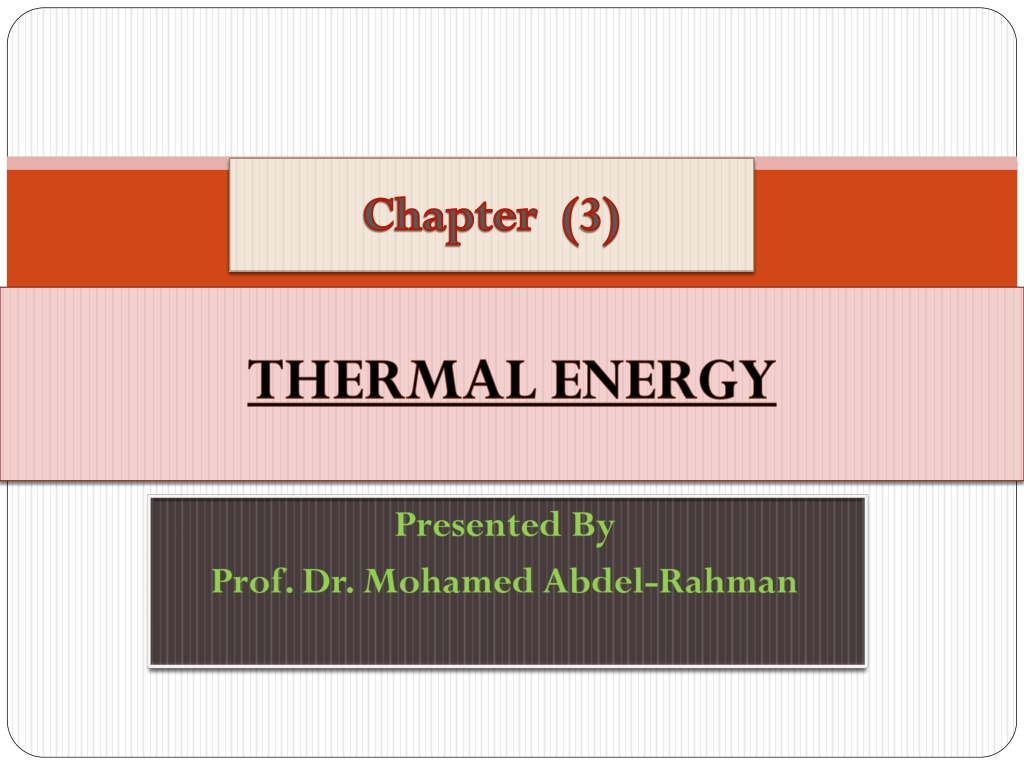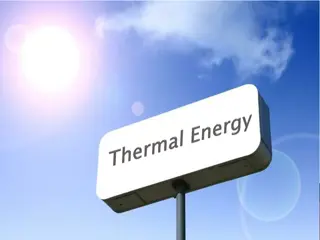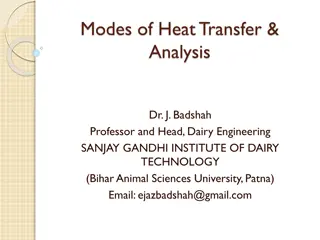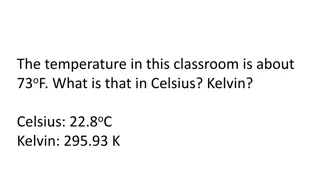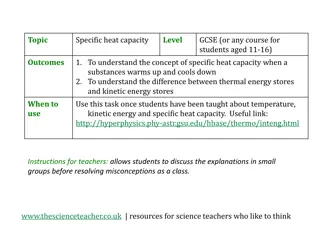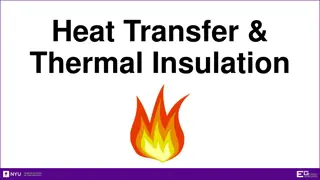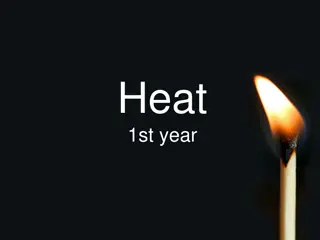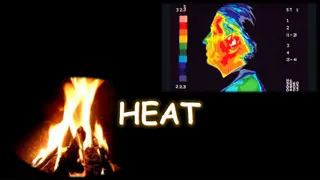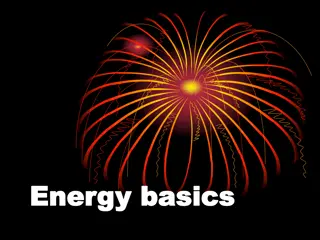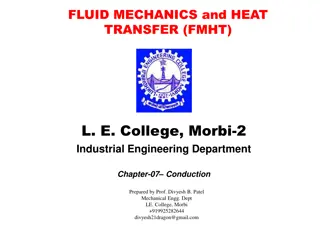Understanding Thermal Energy Transfer and Heat Exchange
Exploring thermal energy in Chapter 3, we delve into concepts like heat, internal energy, specific heat, calorimetry, latent heat, phase change, energy transfer, and global warming. Discover how energy moves between objects of different temperatures and learn about the definitions and units of heat and internal energy in various systems.
Download Presentation

Please find below an Image/Link to download the presentation.
The content on the website is provided AS IS for your information and personal use only. It may not be sold, licensed, or shared on other websites without obtaining consent from the author. Download presentation by click this link. If you encounter any issues during the download, it is possible that the publisher has removed the file from their server.
E N D
Presentation Transcript
THERMAL ENERGY THERMAL ENERGY 3.1. Heat and Internal Energy 3.2. Specific Heat 3.3. Calorimetry 3.4. Latent Heat and Phase Change 3.5. Energy Transfer 3.6 .Global Warming and Greenhouse Gases
THERMAL ENERGY (cont.) When two objects with different temperatures are placed in thermal contact, the temperature of the warmer object decreases while the temperature of the cooler object increases. With time they reach a common equilibrium temperature somewhere in between their initial temperatures. During this process, we say that energy is transferred from the warmer object to the cooler one. James Joule (1818 1889) and others showed that the decrease in mechanical energy of an isolated system was equal to the increase in internal energy of the system. Today, internal energy is treated as a form of energy that can be transformed into mechanical energy and vice versa. This chapter focuses on some of the processes of thermal energy transfer between a system and its surroundings.
THERMAL ENERGY(cont.) 3.1. Heat and Internal Energy Heat involves a transfer of internal energy from one location to another. The following formal definitions will make the distinction precise. Internal energy (U) is the energy associated with the atoms and molecules of the system. The internal energy includes kinetic and potential energy associated with the random translational, rotational, and vibrational motion of the particles that make up the system, and any potential energy bonding the particles together. The internal energy of a monatomic ideal gas is associated with the translational motion of its atoms. In this special case, the internal energy is the total translational kinetic energy of the atoms; the higher the temperature of the gas, the greater the kinetic energy of the atoms and the greater the internal energy of the gas. Internal energy is also associated with the intermolecular potential energy (bond energy) between molecules in a liquid or solid.
THERMAL ENERGY(cont.) Heat is one possible method of transferring energy between a system and its environment, and we provide a formal definition here: Heat is the transfer of energy between a system and its environment due to a temperature difference between them . The symbol Q is used to represent the amount of energy transferred by heat between a system and its environment. the energy Q transferred to a system . Heat is the transfer of thermal energy, just as work is the transfer of mechanical energy.
THERMAL ENERGY(cont.) Units of Heat: The calorie (cal) was used as unit for heat. The calorie is defined as the energy necessary to raise the temperature of 1 g of water from 14.5 C to 15.5 C . (The Calorie used in describing the energy content of foods) In 1948 scientists agreed that because heat (like work) is a measure of the transfer of energy, its SI unit should be the joule. The calorie is now defined to be exactly 4.186 J:- This definition makes no reference to raising the temperature of water. The calorie is a general energy unit, introduced here for historical reasons. The definition in Equation 1 is known as the mechanical equivalent of heat.
THERMAL ENERGY(cont.) 3.2. Specific Heat: The historical definition of the calorie is the amount of energy necessary to raise the temperature of one gram of a specific substance water by one degree. That amount is 4.186 J. Raising the temperature of one kilogram of water by 1 C requires 4 186 J of energy. The amount of energy required to raise the temperature of one kilogram of an arbitrary substance by 1 C varies with the substance. For example, the energy required to raise the temperature of one kilogram of copper by 1.0 C is 387 J. If a quantity of energy Q is transferred to a substance of mass m, changing its temperature by T = Tf Tithe specific heat c of the substance is defined by: SI unit: Joule per kilogram-degree Celsius (J / kg . C)
THERMAL ENERGY(cont.) From the definition of specific heat, we can express the energy Q needed to raise the temperature of a system of mass m by T as: The energy required to raise the temperature of 0.5 kg of water by 3. C: Q = (0.5 kg)(4 186 J/kg. C)(3 C) = 6.28 x 103J. Note that when the temperature increases, T and Q are positive, corresponding to energy flowing into the system. When the temperature decreases, T and Q are negative, and energy flows out of the system. Table 1. List of specific heats for several substances. From the definition of the calorie, the specific heat of water is 4 186 J/kg. C.
THERMAL ENERGY(cont.) APPLICATIONS (1) From the definition of the calorie, the specific heat of water is 4186 J/kg. C. Water has the highest specific heat relative to most other common substances. This high specific heat is responsible for the moderate temperatures found in regions near large bodies of water. As the temperature of a body of water decreases during winter, the water transfers energy to the air, which carries the energy landward when prevailing winds are toward the land. Winters are generally colder because the prevailing winds tend to carry the energy away from land. (2) The fact that the specific heat of water is higher than the specific heat of sand is responsible for the pattern of airflow at a beach. During the day, the Sun adds roughly equal amounts of energy to the beach and the water, but the lower specific heat of sand causes the beach to reach a higher temperature than the water. As a result, the air above the land reaches a higher temperature than the air above the water. The denser cold air pushes the less dense hot air upward (due to Archimedes principle), resulting in a breeze from ocean to land during the day. Because the hot air gradually cools as it rises, it subsequently sinks, setting up the circulation pattern shown in Figure.
THERMAL ENERGY(cont.) Circulation of air at the beach. On a hot day, the air above the sand warms faster than the air above the cooler water. The warmer air floats upward due to Archimedes s principle, resulting in the movement of cooler air toward the beach.
